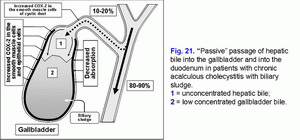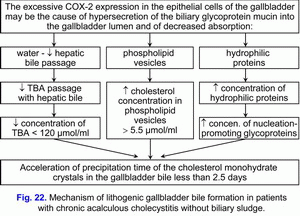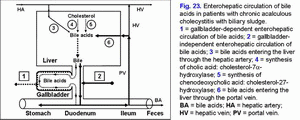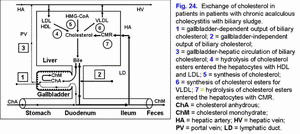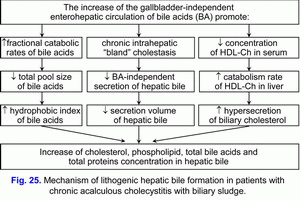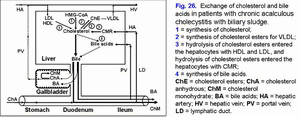
Русский | English
Chronic acalculous cholecystitis with biliary sludge |
Chronic acalculous cholecystitis with biliary sludge is an inflammatory disease, which affects the gallbladder wall and causes motoric-tonic dysfunction of the biliary tract, which is accompanied by appearance of hyperechogenic particles in the gallbladder lumen and reveals as biliary pain (1, 2). The cause of the gallbladder motility disorders can be caused by increased basal cystic duct resistance or cystic duct spasm, muscle hypertrophy, and chronic aseptic inflammation in the gallbladder wall. “Biliary sludge” is designated as any heterogeneity of gallbladder bile found with ultrasound examination (2). Biliary sludge is the result of precipitation of calcium bilirubinate granules, cholesterol monohydrate crystals and polymerized glycoprotein biliary mucin in gallbladder bile (3-7). Only cholesterol monohydrate crystals are the hyperehogenic particles without an acoustic shadow at sonography (3, 5). Biliary sludge is often found in women during pregnancy, in obese patients on a very-low-calorie diet (rapid weight loss), in patients with high spinal cord injuries, prolonged total parenteral nutrition, prolonged treatment with octreotide, and in patients after gastrectomy or colectomy (8). According to the position in the gallbladder and the form biliary sludge is classified in diffused, surface, and precipitating (9). The dynamics of the transformation of biliary sludge into cholesterol gallstones has been shown as follows: diffused biliary sludge → precipitating biliary sludge → a cholesterol gallstone without acoustic shadow → a cholesterol gallstone with acoustic shadow (9). The transformation time of biliary sludge into cholesterol gallstones in the gallbladder makes up 3-36 months (8). Depending on cause the percentage of transformation may change from 5% to 50%. Biliary sludge and cholesterol gallstones are formed in 25-50% of obese patients during very-low-calorie diet within 3-6 months, in 40% of obese patients within 6 months after surgery (8). Approximately 25% of obese patients who undergo strict dietary restriction develop gallstones, and as many as 50% of patients who undergo gastric bypass develop gallbladder sludge or gallstones within six months after surgery (8). As many as 40% of these patients will develop symptoms related to gallstones within the some six-month period (8). A decreased incidence in gallstone formation of 28% to 3% in obese patients on a very-low-calorie diet when they received 600 mg/day ursodeoxycholic acid (8). As many as 45% of adults will develop gallstones after 3 to 4 months of total parenteral nutrition (8). The incidence of new sludge and stone formation during pregnancy is approximately 30% and 2%, respectively (8). After delivery, gallbladder motility returns to normal and biliary sludge disappears in 60% to 70% and stone disappears in 20% to 30% of women (8). In patients with biliary sludge who were followed prospectively, 8% were shown to develop asymptomatic gallstones and 6% developed symptomatic stones requiring cholecystectomy after 38 months (8). In 18% of the patients, the biliary sludge disappeared spontaneously; in the remaining 60%, the biliary sludge disappeared and subsequently reappeared (8). Complications such as acute cholecystitis have been reported to occur in as many as 20% of patients with biliary sludge (8). It is clear from these and other studies that biliary sludge can be a precursor to stone formation and can be a source of potential complications (8). Russian gastroenterologists single out 3 main types of biliary sludge, which have most clear ultrasound descriptions (2):
Diagnostic criteria of the chronic acalculous cholecystitis with biliary sludge
Causes of the gallbladder evacuation dysfunction, biliary pain and chronic aseptic inflammation in the gallbladder wall
Mechanism of development of pathologic disordersHigh degree of COX-2 expression in the smooth muscle cells of the gallbladder wall causes decrease in the evacuation function of the gallbladder and “active” passage of the hepatic bile into the gallbladder (fig. 21). Surplus COX-2 expression in the epithelial cells of the gallbladder mucosa causes decrease in the absorption function of the gallbladder (decrease of water and biliary cholesterol absorption) and “passive” passage of the hepatic bile into the gallbladder (fig. 21). This is accompanied by decrease in concentration of total bile acids in the gallbladder bile and increase in concentration of biliary cholesterol in the phospholipid vesicles, and causes disturbance in colloidal stability of the gallbladder bile and precipitation of cholesterol monohydrate crystals from unstable multilamellar aggregated phospholipid vesicles and calcium bilirubinate granules, i.e. formation of “lithogenic” gallbladder bile (fig. 22). High degree of COX-2 expression in the epithelial cells of the gallbladder mucosa causes hypersecretion of glycoprotein mucin into the gallbladder lumen and gallbladder bile. Increase in concentration of glycoprotein biliary mucin in the gallbladder bile over 2.0 mg/ml helps in its polymerization and formation of sites of the excessive viscosity and it is accompanied by rise of gallbladder bile viscosity. Precipitation of cholesterol monohydrate crystals and calcium bilirubinate granules in the sites of the excessive viscosity of polymerized glycoprotein biliary mucin causes formation of biliary sludge, increase its echogenicity and its reveal during ultrasonographic examination. Decrease in “active” and “passive” passage of the hepatic bile into the gallbladder causes increase in passage of hepatic bile into the duodenum and gallbladder-independent enterohepatic circulation of bile acids, biliary cholesterol and biliary bilirubin (fig. 23). Increase in the gallbladder-independent enterohepatic circulation of bile acids causes increase in concentration of bile acids in the hepatocytes and decrease in the accumulation function and excretion function of liver (i.e. formation of chronic “bland” intrahepatic cholestasis) (fig. 23). Increase in the gallbladder-independent enterohepatic circulation of biliary cholesterol helps in increase in absorption of biliary cholesterol in the small intestine, the biliary cholesterol entering hepatocytes, and the hypersecretion biliary cholesterol into hepatic bile (fig. 24). These two factors contribute to the formation of the “lithogenic” hepatic bile (fig. 25). Decrease in the gallbladder-dependent output of biliary cholesterol and in the concentration of total bile acids in the gallbladder bile results in formation of the “lithogenic” gallbladder bile and precipitation of the cholesterol monohydrate crystals in the gallbladder lumen in 100% of patients with chronic acalculous cholecystitis with biliary sludge (fig. 26). Long-term storage of biliary sludge and gallbladder hypomotility contributes to the gallstones formation in the gallbladder and transformation of chronic acalculous cholecystitis with biliary sludge into chronic calculous cholecystitis. Pathogenetic treatment of patients with chronic acalculous cholecystitis with biliary sludgeAccordingly, treatment of the chronic acalculous cholecystitis with biliary sludge (with biliary pain) aiming for the prophylactics of the chronic calculous cholecystitis, duodeno-gastral reflux, antral atrophic (bile acid-dependent) gastritis and chronic biliary pancreatitis includes:
Celebrex (Celecoxib) is a selective inhibitor of COX-2. Inhibiting COX-2 activity in the smooth muscle cells of the gallbladder wall and cystic duct it brings relief of the biliary pain within 3-5 days, restoration of the evacuation function of the gallbladder and the gallbladder-dependent output of the biliary cholesterol, “active” and “passive” passage of the hepatic bile into the gallbladder, and decrease in the gallbladder-independent enterohepatic circulation of bile acids, biliary cholesterol and biliary bilirubin. Celebrex (Celecoxib), a selective inhibitor of COX-2, inhibiting COX-2 activity in the epithelial cells of the gallbladder mucosa causes inhibition in glycoprotein mucin hypersecretion into the gallbladder lumen, decrease in concentration of glycoprotein biliary mucin in gallbladder bile and gallbladder bile viscosity, which prevents formation of biliary sludge. Low COX-2 activity in the epithelial cells of the gallbladder mucosa helps in restoration of the absorption function of the gallbladder (absorption of water and biliary cholesterol), which results in increase in concentration of total bile acids and decrease in concentration of biliary cholesterol in gallbladder bile. Ursofalk (ursodeoxycholic acid), is a hydrophilic hepatoprotective bile acid. It helps in dissolving the cholesterol monohydrate crystals in the gallbladder, decrease in lithogenicity of gallbladder and hepatic bile, disappearance of the chronic “bland” intrahepatic cholestasis (i.e. results in restoration of the accumulation and excretion functions of liver). Celebrex (Celecoxib) and Ursofalk (ursodeoxycholic acid), blocking main pathogenetic mechanisms of gallstones formation, contribute to elimination of biliary sludge in 100% of cases, and lower the repeated risk of biliary sludge formation, and, respectively, reduce risk of gallstone formation in the gallbladder. Effectiveness is 95%.
Attention!!! Information for patients: Before using this scheme of treatment please check the contraindications (below) and side effects of using pharmacological preparations of Celebrex (Celecoxib) and Ursofalk (ursodeoxycholic acid), and obtain your doctor’s permission. Contraindications for Celebrex (Celecoxib):
Contraindications for Ursofalk (ursodeoxycholic acid):
This web page does not bear any legal responsibility for the use of the proposed treatment schemes without consulting your doctor.
References:
|
|
|
